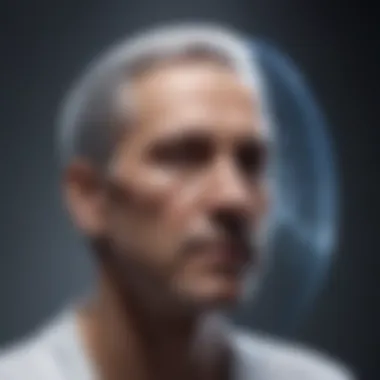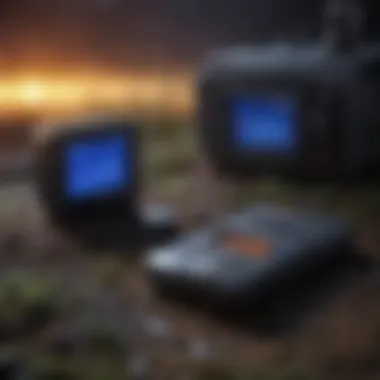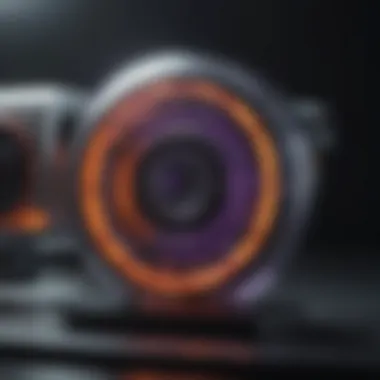Ultraviolet Devices: Applications and Innovations


Intro
Ultraviolet (UV) devices represent a fascinating intersection of science and technology, wielding significant influence across various fields. Their utility extends beyond mere illumination, finding critical roles in healthcare, environmental monitoring, and material processing. Understanding the implications and applications of these devices involves exploring the scientific principles that underlie their functionality, as well as the innovations that continue to push the boundaries of their effectiveness.
As the demand for effective sanitation and sterilization methods grows, especially in healthcare, the importance of UV devices cannot be overstated. They operate primarily through the emission of ultraviolet light, which can disrupt the cellular structures of microorganisms, making them valuable tools in infection control. Additionally, their application in environmental monitoring underscores their versatility, as they can detect and analyze pollutants in air and water.
This article aims to dissect the various dimensions of UV devices, providing a detailed analysis of both their benefits and limitations. Furthermore, it will delve into the regulatory considerations that influence their use in various settings. By combining technical knowledge with practical insights, the article seeks to shed light on the significance of ultraviolet devices in today's modern scientific and industrial landscape.
Preface to Ultraviolet Devices
Ultraviolet devices play a crucial role in a variety of scientific and industrial applications. The importance of understanding these devices lies in their capacity to harness specific wavelengths of ultraviolet light for practical uses that range from healthcare to environmental monitoring. This section examines how these devices work, their historical significance, and the advancements that have shaped their evolution.
Definition and Overview
Ultraviolet (UV) devices are instruments that emit ultraviolet light, which exists beyond the visible spectrum. UV radiation is categorized into three types: UVA, UVB, and UVC. Each type has distinct properties and applications. UVA rays are typically associated with skin aging, while UVB rays are linked to skin burns. UVC, however, holds immense potential in disinfection technologies due to its germicidal properties.
The primary function of UV devices is to utilize these properties for various applications, such as sterilization, water purification, and the curing of materials. For instance, UVC light is highly effective in killing bacteria and viruses, making it invaluable in medical settings.
History of Ultraviolet Technology
The history of ultraviolet technology can be traced back to the 19th century when scientists began to explore the properties of light. In 1801, Johann Wilhelm Ritter discovered ultraviolet light while experimenting with different light sources. This marked the beginning of understanding the potential applications of UV radiation.
Over the decades, significant advancements have taken place. The first practical use of UV light for disinfection was in the early 20th century, particularly in water treatment facilities. During this time, the ability to kill harmful microorganisms without chemicals revolutionized public health.
In recent years, innovations in UV technologies, such as LED UV systems, have transformed the landscape further. These LED systems offer energy-efficient alternatives, extending the applications of ultraviolet devices into contemporary settings. Today, understanding the historical context of these devices contributes to recognizing their impact and future potential in technology, healthcare, and environmental monitoring.
The Science of Ultraviolet Light
Understanding the science of ultraviolet light is essential in comprehending the broader implications and applications of ultraviolet devices in various fields. Ultraviolet light exists in a spectrum, playing a critical role in many biological and chemical processes. The devices utilizing these specific wavelengths harness their unique properties for numerous applications, such as sterilization and environmental monitoring.
Types of Ultraviolet Radiation
UVA
UVA radiation makes up most of the ultraviolet light that reaches the Earth. It is known for penetrating deep into the skin and causing damage over time. An essential characteristic of UVA is its long wavelength, ranging from 320 to 400 nanometers. This property is beneficial in applications such as tanning and certain medical treatments. Its ability to penetrate skin layers makes it a common choice for dermatological devices aimed at treating skin disorders. However, its potential to contribute to skin aging and cancer is a significant disadvantage.
UVB
UVB radiation occupies the 280 to 320 nanometer range. It is crucial for the synthesis of vitamin D in the skin, which is a vital component for human health. In contrast to UVA, UVB has a shorter wavelength and thus doesn't penetrate as deeply into the skin. This characteristic makes it particularly useful in applications like phototherapy for skin conditions, as it can provide targeted treatment. However, excessive exposure to UVB can lead to skin burns and increased risk of skin cancer, which poses a significant health risk.
UVC
UVC radiation, ranging from 100 to 280 nanometers, effectively destroys microorganisms, making it valuable for disinfection purposes. This type of radiation has a strong germicidal effect, making it a preferred choice in sterilizing water and surfaces in healthcare settings. The key advantage of UVC lies in its ability to inactivate pathogens, which is especially useful in preventing the spread of infections. Nevertheless, UVC can be harmful to humans, leading to skin and eye injuries, indicating a necessity for proper safety measures in its application.
Mechanisms of Action
Photobiological Effects
Photobiological effects describe how ultraviolet light interacts with biological systems. These interactions can result in various outcomes, such as cell damage or the activation of certain biological processes. The key characteristic of these effects is their ability to promote or inhibit biological activities depending on the type of UV radiation involved. In the context of this article, understanding photobiological effects is critical since they underpin the therapeutic benefits of ultraviolet devices. However, these effects can have disadvantages, including potential cellular mutations or skin damage resulting from overexposure.
Chemical Reactions
Chemical reactions induced by ultraviolet light are another vital mechanism of action. UV light can initiate photochemical reactions, leading to the breakdown of complex molecules or the formation of new substances. This characteristic is particularly useful in industrial applications such as polymer curing. Moreover, the unique feature of UV-induced chemical reactions is their rapid progression, which can be advantageous in settings requiring quick processing. However, these reactions sometimes lead to unwanted byproducts, making careful control necessary to maximize benefits while minimizing drawbacks.
Applications of Ultraviolet Devices
Ultraviolet devices have a significant role in various sectors, fundamentally transforming how specific tasks are performed. The applications of UV technology span across healthcare, environmental monitoring, and industrial processes. Understanding these applications is crucial as they profoundly impact public health, environmental safety, and material efficiency.


Healthcare and Sterilization
Disinfection of Surfaces
Disinfection of surfaces is a crucial application of UV devices in healthcare settings. With the increase in awareness about infection control, UV light has emerged as a reputable solution. One key characteristic of surface disinfection is its ability to eliminate up to 99.9% of pathogens. This high efficacy rate makes it a popular choice for hospitals and medical centers.
The unique feature of UV disinfection is its mechanism of destroying microorganisms by altering their DNA or RNA. This characteristic ensures that pathogens cannot reproduce, thereby preventing infections. However, while UV disinfection is highly effective, it does have limitations. For instance, it requires direct exposure to the surface and may not be effective in shadowed areas.
Water Purification
Water purification is another vital application of ultraviolet devices. The use of UV light in this process ensures that harmful pathogens in water are effectively neutralized. A key characteristic of this application is its speed; UV treatment can purify water almost instantaneously.
The unique feature of water purification through UV technology is its lack of residual chemicals. Unlike traditional methods, UV treatment does not introduce substances that may affect water quality. However, it does not provide long-term protection, meaning water must be used quickly after treatment to prevent recontamination.
Medical Equipment Sterilization
Medical equipment sterilization using ultraviolet light plays a crucial role in maintaining hygiene standards in healthcare. The ability of UV radiation to kill a wide range of microorganisms makes it particularly valuable. This method is often preferred because it is chemical-free and leaves no residues, ensuring that tools remain safe for patient use.
The unique feature of UV sterilization is its efficiency in sterilizing complex instruments that are hard to clean. Nonetheless, it also has drawbacks, including the necessity for the equipment to be clean before treatment. Dirt or organic matter can block UV light, reducing effectiveness.
Environmental Monitoring
Detection of Pathogens
Detection of pathogens is of critical importance in environmental monitoring. UV devices can quickly identify the presence of harmful microorganisms in various environments, such as water and air. The key characteristic of this application is its ability to monitor in real-time.
The unique feature of using UV for pathogen detection is the precision and speed it offers compared to traditional methods. However, it might require specialized training to interpret the results accurately, which can be a hurdle in some cases.
Air Quality Assessment
Air quality assessment using ultraviolet technology is an essential application for ensuring public health. UV devices can measure various pollutants in the air, helping to maintain safe levels. A key characteristic is the ability to provide continuous monitoring, which is integral for urban planning and public health policies.
The unique aspect of air quality assessment is that it gives immediate feedback on pollution levels, enabling swift actions if necessary. However, the system can be complex and expensive to implement, limiting its application in some areas.
Industrial Applications
UV Curing of Coatings
In industrial applications, UV curing of coatings is essential for drying inks and coatings on various materials. This technology is valued for its rapid curing times, significantly speeding up production processes. The benefit of using UV curing is the reduction of volatile organic compounds that are common in traditional curing methods.
A unique feature of UV curing is the consistency achieved in coating applications, providing a high-quality finish. However, it requires careful handling, as improper curing can lead to defects.
Material Processing
Material processing is another significant application of ultraviolet devices in industries. This technology can modify surface properties of materials, enhancing adhesion and resistance. A key characteristic is its environmental benefit, as it often reduces the need for solvents.
The distinctive feature of UV material processing is its precision, allowing for tailored applications on different substrates. Despite its advantages, it can be costly to implement at scale, limiting some operations from adopting the technology effectively.
Innovations in Ultraviolet Technologies
The field of ultraviolet technology is rapidly evolving. Innovations in this area can significantly enhance the effectiveness and efficiency of UV applications across various domains. An understanding of these innovations is critical for maintaining and improving the functionality of UV devices in healthcare, environmental monitoring, and industrial settings. These advancements serve not only to improve public health standards but also to pave the way for new applications that can address complex challenges.
Advancements in UV Lamp Technology
LED UV Technologies
LED UV technologies are transforming the landscape of ultraviolet applications. One of the main benefits of LED UV systems is their energy efficiency. They consume less power compared to traditional UV sources, leading to lower operational costs. This energy efficiency aligns with a growing emphasis on sustainability in technology.
A unique feature of LED UV technologies is their ability to produce specific wavelengths of ultraviolet light. This capability allows for precision in applications such as sterilization and curing. The focused output improves the effectiveness of the devices, enabling better results in healthcare and industrial processes. However, the initial investment in LED technology can be higher than traditional lamps, which may deter some users.


Broadband UV Sources
Broadband UV sources also deserve attention due to their wide range of applications. These sources emit a spectrum of UV light that covers multiple wavelengths, making them applicable for various sterilization tasks and photochemical reactions. The key characteristic of broadband UV sources is their flexibility, which makes them useful in diverse settings from laboratories to factories.
A distinct advantage of broadband UV sources is their ability to handle larger surfaces or volumes simultaneously, thus increasing productivity. Nevertheless, they can generate unwanted heat and may require additional cooling systems, escalating operational costs and complicating maintenance.
Emerging Applications
UV-Based Treatment for Skin Conditions
The medical industry is exploring UV-based treatment for skin conditions, particularly psoriasis and eczema. This application highlights the therapeutic potential of ultraviolet light in dermatology and reflects a growing trend toward non-invasive treatment methods. This specific aspect of UV therapy is appealing due to its effectiveness and relatively low risk of side effects.
Patients benefit from the precise targeting of affected skin areas, resulting in significant improvements without extensive drug regimens. The unique feature of this therapy is its ability to harness the natural properties of UV light to reduce inflammation and promote healing. However, practitioners must monitor exposure levels to avoid adverse effects such as skin damage.
Commercial Food Safety
The food industry is increasingly adopting UV technologies to enhance food safety and extend shelf life. This application underscores the strengths of UV devices in preventing microbial contamination without the use of chemicals. The key characteristic of using UV light for food safety is its efficiency in disinfection processes.
Key features include its rapid action, as it can effectively reduce pathogen levels on food surfaces in mere seconds. This technology not only improves safety standards but also meets consumer demand for clean and safe food products. The disadvantage includes potential alterations in food quality if not applied correctly. Care must be taken to ensure that nutrient content remains intact while achieving microbial safety.
Safety and Regulatory Considerations
Understanding safety and regulatory considerations is vital when discussing ultraviolet devices. The capabilities of UV devices can present certain health risks. Identifying and mitigating these risks is crucial not only for user safety but also for compliance with legal standards. Regulatory guidelines help ensure that these devices are used properly, reducing potential harm.
Health Risks Associated with UV Exposure
Skin Damage
Skin damage due to UV exposure is a significant concern. Prolonged or unprotected exposure to ultraviolet light can lead to various skin conditions. The most notable is sunburn, but long-term exposure can increase the risk of skin cancer and premature aging. This risk highlights the need for protective measures for individuals working with or around these devices.
Key characteristics of skin damage include its visible effects and long-term health implications. Skin damage is a critical point in this article because it underscores the need for compliance with safety measures. Understanding the unique feature of skin damage emphasizes the importance of appropriate shielding and usage guidelines. The advatages of raising awareness about this risk include promoting protective behavior and compliance with regulations.
Eye Injury
Eye injury represents another significant risk associated with UV exposure. Ultraviolet light can cause immediate injuries, such as photokeratitis—burning of the cornea—and long-term conditions such as cataracts. Eye protection is essential for all personnel involved with UV devices.
A key characteristic to highlight is that eye injuries can occur without immediate symptoms. This delayed response makes it even more essential for proper safety measures to be in place. The presence of effective eye protection devices can serve as a preventative measure, significantly reducing the incidence of such injuries. Overall, eye injury awareness is crucial for occupational safety within environments that utilize UV technologies.
Regulatory Guidelines
OSHA Standards
Occupational Safety and Health Administration (OSHA) standards play a pivotal role in the safety of workers using ultraviolet devices. OSHA establishes regulations that aim to ensure safe working conditions and limit exposure to harmful UV radiation. These standards provide structured guidelines on the permissible levels of UV exposure in different working environments.
The key characteristic of OSHA standards is their emphasis on prevention through training and proper equipment. This focus is beneficial as it encourages workplace safety and fosters a culture of awareness. One unique feature of these regulations is the requirement for regular monitoring of UV exposure, which helps to identify risks proactively and ensure compliance. Their advantages include fostering a safer working environment while also minimizing potential liabilities faced by employers.
FDA Compliance
Food and Drug Administration (FDA) compliance is critical when it comes to UV devices used in medical and food safety applications. The FDA ensures that UV devices meet specific safety and effectiveness requirements. Compliance facilitates trust in the technology, assuring users that devices are tested and certified.
The key characteristic of FDA compliance is its rigorous review process. This ensures devices are safe for both patients and consumers. The unique feature of this regulatory compliance is its dual focus on public health and technological innovation. FDA guidelines ensure that UV technologies are not only effective but also implemented in a way that minimizes risks. This compliance promotes a safe environment for users, thereby enhancing the overall credibility of ultraviolet technology.
"Safety is not just about compliance; it is an ongoing commitment to a culture that values health and well-being."
Challenges and Limitations
Ultraviolet devices offer a range of benefits across various sectors, but they also come with significant challenges and limitations. Understanding these aspects is critical for effective implementation and application in different contexts. Addressing these issues will not only enhance the usability of UV technology but also help stakeholders make informed decisions about their deployment.


Effectiveness in Different Environments
The effectiveness of ultraviolet devices can vary greatly depending on their environment. The conditions under which these devices operate significantly impact their performance. For instance, UV light can be absorbed or scattered by various materials present in the surroundings. This is particularly true in aqueous environments, where turbidity and the presence of organic matter can significantly reduce the efficacy of UV disinfection processes.
In air purification settings, factors such as humidity and airflow can also affect how well UV devices work. Devices placed in confined spaces, for example, may struggle with the even distribution of UV light, potentially resulting in areas of shadow where pathogens could thrive. Thus, a thorough analysis of the specific environment and the potential interferences should be conducted prior to the implementation of UV solutions.
Additionally, it is important to note that continuous exposure to UV radiation can lead to the degradation of certain materials and surfaces. This means that prolonged use of UV devices in sensitive environments may necessitate regular assessments of structural integrity or equipment lifespan.
Operational Costs and Maintenance
Another significant consideration is the operational costs and maintenance associated with ultraviolet devices. While the initial setup costs can often be justified due to the health and safety benefits, ongoing expenditure can be a deterrent for some organizations. Specific elements that contribute to these costs include electricity usage, replacement of UV lamps, and regular maintenance required to ensure optimal performance.
The life expectancy of UV lamps is typically limited, with options ranging from several months to a few years depending on the technology. This necessitates a schedule for lamp replacements, impacting both budget and operational efficiency. Organizations must also account for potential downtime during maintenance or lamp replacement, which can disrupt service delivery in critical sectors such as healthcare.
Proper maintenance is essential to maintaining the effectiveness of UV devices. This may involve routine cleaning of the lamp surfaces, calibration of installed systems, and inspection of the surrounding environment to ensure there is minimal interference. Failure to uphold these maintenance practices may lead to reduced performance and increased operational costs in the long run.
In summary, while ultraviolet devices hold great promise, it is essential to consider both their effectiveness in various environments and the costs associated with their operation and maintenance. Understanding these challenges may foster better implementation strategies and enhance their overall utility across different sectors.
Future Trends in Ultraviolet Technology
The landscape of ultraviolet technology is constantly evolving. Current innovations drive advancements across various domains. Understanding these future trends is crucial. They reveal how ultraviolet devices may further improve sectors like healthcare and environmental safety. As technology grows, so too will the potential of UV applications.
Integrating UV with Smart Technologies
Integrating ultraviolet technology with smart systems represents a promising avenue. This integration allows for real-time monitoring and automation of UV device functions. For instance, smart sensors can adjust UV output based on environmental conditions. Such adaptability enhances both efficacy and safety.
Moreover, smart technologies can facilitate remote diagnostics and predictive maintenance. This capability helps in assessing device performance over time. As a result, operators can prevent breakdowns. This can lead to improved operational efficiency and cost savings.
Benefits of this integration include:
- Enhanced user control through apps
- Real-time data analytics for better decision-making
- Increased safety measures via automated alerts
The alignment of UV technology with the Internet of Things (IoT) continues to grow. Sensors and devices will better communicate, leading to more responsive UV solutions. This trend underscores the forward-thinking nature of ultraviolet device applications.
Global Research Initiatives
The global research community plays a significant role in advancing ultraviolet technologies. New initiatives focus on enhancing UV efficacy and expanding its applications. Collaborative efforts spearheaded by universities and research institutions cultivate innovation.
Notable areas of research include:
- Developing more efficient UV light sources
- Exploring ultraviolet's role in treating advanced materials
- Investigating its potential in new fields such as agriculture
"Cutting-edge research is paramount for unlocking the full potential of ultraviolet technology and its applications in diverse fields."
Such initiatives often receive funding from various governments and organizations. This support highlights the increasing recognition of UV technology's importance in public health and safety. Participation in international conferences and consortiums enhances knowledge sharing on a global scale.
In summary, the future of ultraviolet technology looks promising. Integrating smart tech and supporting research initiatives are vital for ongoing development. These efforts will allow ultraviolet devices to adapt and thrive in an ever-changing technological landscape.
Culmination
The conclusion of this article serves to emphasize the critical role that ultraviolet (UV) devices play in multiple fields. Understanding the impact of UV technology is essential for educators, researchers, and medical professionals. UV devices not only showcase the evolution of scientific advancements but also highlight the practical implications in real-world scenarios.
Summarizing the Impact of UV Devices
Ultraviolet devices offer several benefits across various sectors. In healthcare, they are utilized for sterilization processes, significantly reducing the risk of infection in medical environments. The ability to disinfect surfaces and purify water effectively demonstrates their practical applications, making them invaluable tools in combatting pathogens. Moreover, industries are leveraging UV technologies in manufacturing, which enhances production efficiency and product quality.
- Healthcare Benefits: Reduction of infection rates, effective sterilization of medical tools.
- Environmental Impact: Enhanced detection of pathogens and monitoring of air quality.
- Industrial Usage: Increased efficiency in curing processes and overall material manufacturing.
Additionally, the ongoing innovations in UV technology, such as the development of LED UV sources and the integration of smart technologies, pave the way for more versatile applications. These advancements encourage a paradigm shift in how we perceive UV devices and their utility.
Call for Continued Research and Development
While the innovations in ultraviolet technology have been promising, there is a critical need for continuous research and development. Exploring new applications and improving existing technologies can lead to greater efficiencies and safety in UV device usage. It is crucial to address the challenges associated with UV exposure and ensure safety regulations are strictly adhered to. Understanding the health risks while maximizing benefits must be at the forefront of future studies.
In summary, the future of ultraviolet devices hinges on collaborative efforts from researchers, industry professionals, and regulatory bodies. This synergy will ensure that the promising potential of UV technologies is fully realized, bringing significant advancements in public health, environmental protection, and industrial efficiency.







